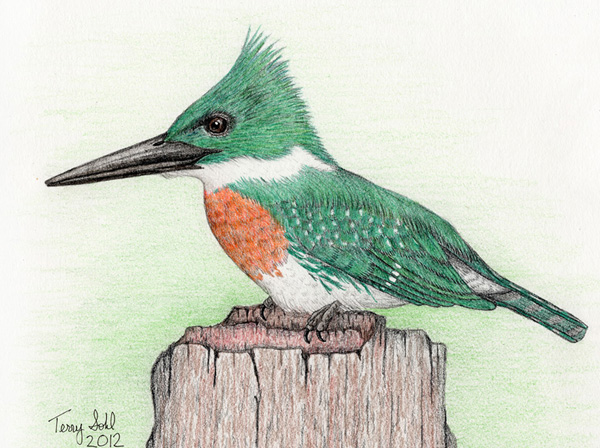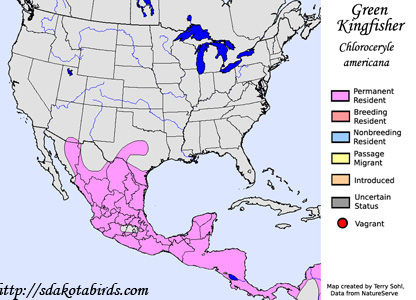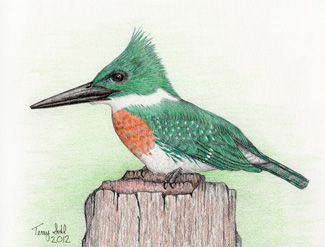| Length: 8.75 inches | Wingspan: 12 inches | Seasonality: Non-resident in South Dakota |
| ID Keys: Greenish upperparts, white collar, long bill, rufous-colored breast on male | ||
 The
Green Kingfisher is a small kingfisher of the tropical Americas, with a
range that just extends in the U.S. in Texas and southern Arizona and New
Mexico. They are often overlooked in areas where they are found, as
they prefer to perch in thick vegetation along stream and river banks.
Both the male and female share similar green plumage on the head and
upperparts, but the male has a rusty-colored breast, while the female has
green and white on the breast.
The
Green Kingfisher is a small kingfisher of the tropical Americas, with a
range that just extends in the U.S. in Texas and southern Arizona and New
Mexico. They are often overlooked in areas where they are found, as
they prefer to perch in thick vegetation along stream and river banks.
Both the male and female share similar green plumage on the head and
upperparts, but the male has a rusty-colored breast, while the female has
green and white on the breast.
Habitat: Found near water, typically along streams and rivers, and typically where there is dense vegetative growth along the shoreline.
Diet: Feeds mostly on small fish, but will also take insects on occasion.
Behavior: Green Kingfishers hunt by observing from a low perch, typically thick vegetation or a branch overhanging the water, and then plunging into the water when a small fish is spotted.
Nesting: The nest is a burrow built into the side of a river bank. Both the male and female help to excavate the nest burrow, which is typically 2 to 3 feet long, and ends in a larger nesting chamber. Both sexes help to incubate the eggs, and both parents help to raise the young.
Song: The call of a Green Kingfisher is a staccato chattering. Also has a short buzzy call that descends in pitch from start to finish.
Migration: Considered a permanent resident throughout their range. Vagrants have occasionally been found a bit north of their typical range in the U.S.
Interactive eBird Map: Click here to access an interactive eBird map of Green Kingfisher sightings
Similar Species: Much smaller size and different plumage makes it easy to identify from other kingfishers found in the U.S. In much of their tropical range they can be confused with the Amazon Kingfisher, as plumage is rather similar between the species. However, the Green Kingfisher is a much smaller species, weighing only about 1/3rd of the weight of an Amazon Kingfisher.
Conservation Status: There are currently no perceived major threats to Green Kingfisher populations, and the IUCN cites it as a species of "Least Concern".
Further Information: 1) Cornell's Neotropical Birds - Green Kingfisher
2) Audubon Guide - Green Kingfisher
3) WhatBird - Green Kingfisher
Image Information: Colored pencil drawing by Terry Sohl - March 2012
| Click below for a higher-resolution map |
 |
| South Dakota Status: Non-resident in South Dakota |
Additional Green Kingfisher Images
Click for a higher-resolution version of these photos

